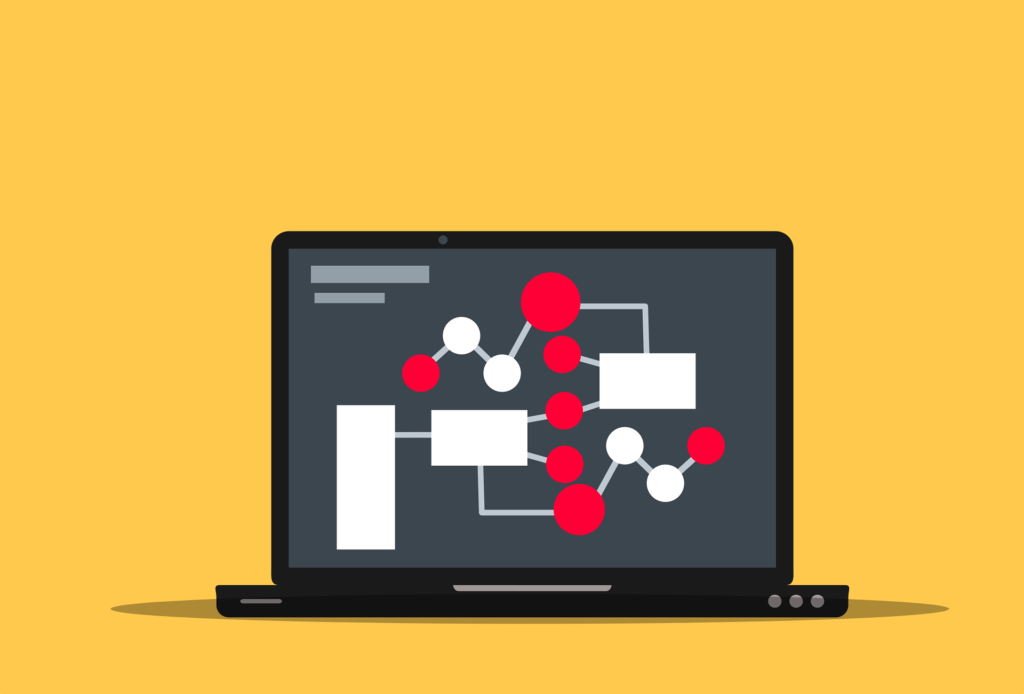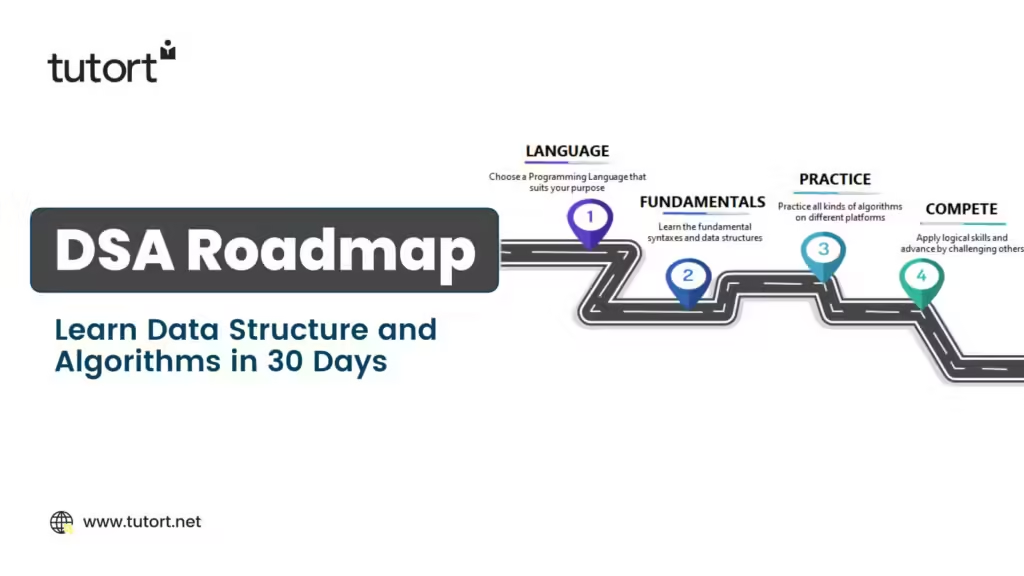
In today’s tech world, mastering data structures and algorithms (DSA) is essential. These concepts are the backbone of efficient software and app development. Moreover, achieving proficiency in DSA can significantly boost your programming skills.
A clear roadmap is crucial for learning DSA effectively. It helps you build strong problem-solving abilities and demonstrates your coding expertise to potential employers. Furthermore, understanding these principles leads to more efficient and accurate code.
This guide will cover the basics of data structures and algorithms, their importance, and how to learn them. Follow these steps to enhance your programming skills and open up new career opportunities. Let’s first understand what is data structures.
Explaining data structures
Understanding data structures is key to organizing and managing data effectively. For beginners, grasping these fundamental concepts can transform your approach to programming.
Essential Data Structures for Beginners:
- Stacks: Manage data in a last-in, first-out manner.
- Linked Lists: Store data in a chain of nodes.
- Queues: Handle data in a first-in, first-out sequence.
- Maps: Use key-value pairs for efficient data retrieval.
- Hash Tables: Offer fast data access with unique keys.
- Search Trees: Organize data hierarchically for quick searches.
- Sets: Manage collections of unique items.
Mastering these data structures improves your ability to write efficient and optimized code. This knowledge lays the groundwork for solving complex problems and advancing your programming skills.
The Purpose of Data Structures and Algorithms: Why They Matter
Data structures and algorithms are the backbone of efficient computing. They help in organizing, managing, and accessing data swiftly, ensuring that information is processed effectively. For anyone preparing for technical interviews, mastering these concepts is crucial.
If you understand how to choose and apply the right data structures and algorithms, it enhances your problem-solving skills. Also, it enables you to handle complex challenges with ease and showcase your ability to optimize solutions. Overall, investing time in learning these fundamentals not only prepares you for interviews but also equips you with essential tools for real-world applications.
Why are data structures and algorithms important?
Data structures and algorithms are essential building blocks of programming. They form the foundation for writing efficient, optimized code. For anyone preparing for technical interviews, having a solid grasp of these concepts can significantly boost your chances of success.
Here’s why learning data structures and algorithms is so important:
- Enhance Problem-Solving Skills: Data structures help organize information, while algorithms provide the steps to solve problems effectively.
- Improve Coding Efficiency: Using the right data structure can speed up your code, making it more efficient and scalable.
- Crucial for Interviews: Many technical interviews focus on data structures and algorithms. Mastering these topics shows your potential employers that you are equipped for real-world challenges.
- Career Advancement: A deep understanding of these concepts can lead to better job opportunities and career growth in tech.
To excel in your coding journey, it’s crucial to learn data structures and algorithms for interviews and long-term success.
How to learn data structures and algorithms in five easy steps?

Learning data structures and algorithms can seem challenging, but breaking it into simple steps makes it easier to tackle. Here’s a clear path to get started.
1. Choose and Master Your Preferred Programming Language
The first step in mastering data structures and algorithms is to choose a programming language that feels comfortable to you. Whether it’s Python, Java, C++, or any other language, pick one that matches with your style and stick to it. A strong command of a single language will make it easier to implement and understand complex concepts. Don’t just follow anybody, experience yourself and then follow it for life.
You can start by learning the basics—syntax, data types, variables, and loops. As you grow familiar, dive into deeper topics like functions and object-oriented programming. Overall, this will help to build your foundation and make it easier to grasp more advanced topics in data structures and algorithms.
2. Understand Time and Space Complexity
Understanding time and space complexity is crucial for learning data structures and algorithms effectively. These concepts help you evaluate how efficiently your code runs and how much memory it consumes. Time complexity measures the time a program takes to run, while space complexity evaluates the memory it uses.
Key points to remember:
- Time Complexity measures the time taken to run an algorithm as the input size grows. Think of it as a stopwatch ticking away as your program executes. Your goal is to keep the time as low as possible, even when the input is large.
- Space Complexity refers to the amount of memory an algorithm uses during execution. It’s like organizing your workspace: the less clutter (memory) you use, the smoother your work will be.
The most common notations used to analyze these complexities include:
- Big-O (O): Worst-case scenario.
- Omega (Ω): Best-case scenario.
- Theta (θ): Average complexity.
Follow the link to learn more about notations along with examples.
You can optimize code and handle larger data efficiently after grasping these concepts.
3. Grasp the Fundamentals of Key Data Structures and Algorithms
To effectively learn data structures and algorithms, you must build a solid foundation in the basics. Mastering these core concepts will not only make you a better programmer but also help you solve complex problems with ease and confidence.
Even though data structures and algorithms are different, they are closely connected. To learn them effectively, you need to follow the right path. If you’re unsure about which to start with, check out our detailed guide: “What Should I Learn First—Data Structures or Algorithms?“
Start with the Essential Data Structures:
- Arrays: Think of arrays as containers that store data in a sequential order. They allow quick access to elements, making them perfect for frequent retrieval tasks.
- Strings: Essentially arrays of characters, strings have their own unique operations like searching, sorting, and concatenation.
- Linked Lists: Unlike arrays, linked lists store elements in nodes connected by pointers. This flexibility makes them great for dynamic data manipulation.
- Stacks and Queues: Both are linear structures but follow different rules: stacks operate in a Last In, First Out (LIFO) manner, while queues work on a First In, First Out (FIFO) principle. These are perfect for handling data where the order of operations is crucial.
- Trees and Graphs: These non-linear structures are designed for hierarchical or networked data. Trees are useful for tasks like database indexing, while graphs are ideal for modelling connections in social networks or road maps.
Delve into Key Algorithms:
- Sorting Algorithms: Learn different ways to arrange data efficiently, such as Quick Sort or Merge Sort. Each has its own advantages depending on the dataset size and requirements.
- Searching Algorithms: Understand the methods to locate data quickly, like Binary Search, which is more efficient than a simple Linear Search in sorted data.
- Divide and Conquer: This technique breaks down a problem into smaller subproblems, solves them, and then merges the results. It is fundamental to algorithms like Merge Sort and Quick Sort.
- Greedy Algorithms: These build a solution step-by-step, always choosing the most advantageous option at each step. They are perfect for optimization problems like the shortest path in a graph.
- Dynamic Programming: This is an optimization over recursion. By storing the results of expensive function calls and reusing them when the same inputs occur, it reduces the computation time.
By understanding these key data structures and algorithms, you will gain the skills needed to solve any programming challenge, build optimized applications, and thrive in your coding journey. Remember, mastering the basics is the first step to mastering programming.
4. Practice Consistently to Sharpen Your Skills
Practice is the key to mastering data structures and algorithms. The more you apply what you’ve learned, the better you’ll understand how to solve problems efficiently. Regular practice not only reinforces concepts but also builds your confidence in tackling different coding challenges.
Also, you can solve problems on platforms like LeetCode, HackerRank, or Codeforces to sharpen your skills. Focus on a variety of questions, ranging from basic to complex. As you consistently practice, you’ll notice improved problem-solving speed and accuracy. This hands-on approach is essential for turning theoretical knowledge into practical expertise.
5. Challenge Yourself and Achieve Mastery
Now that you’ve built a strong foundation, it’s time to push your limits and achieve mastery. Testing your skills against complex problems will help you identify areas for improvement and solidify your understanding.
To challenge yourself:
- Participate in Coding Competitions: Platforms like LeetCode, Codeforces, and HackerRank offer regular challenges.
- Join Algorithmic Contests: Compete in events like Google Code Jam or Facebook Hacker Cup.
- Contribute to Open Source Projects: Real-world coding helps you apply your knowledge and learn from others.
You’ll enhance your skills, stay motivated, and grow into a more confident and proficient programmer by consistently tackling tough problems. Mastery comes when you embrace challenges and keep moving forward.
Tips to take your learning to the next level
Taking your learning to the next level requires more than just understanding the basics. It’s about pushing boundaries, deepening your knowledge, and challenging yourself consistently. Whether you’re mastering new skills or honing existing ones, there are strategies to make your learning more efficient and impactful.
Here are some tips to elevate your learning:
A. Set clear, measurable goals
Break down your larger objectives into smaller, manageable tasks. This makes progress more visible and motivates you to keep moving forward.
B. Embrace active learning
Don’t just passively consume information—actively engage with it. Take notes, ask questions, and apply what you learn in real-life scenarios.
C. Challenge yourself with complex problems
As you grow, focus on solving more challenging problems. This will expand your critical thinking and deepen your understanding.
D. Stay consistent and persistent
Learning is a marathon, not a sprint. Make time for consistent practice, and don’t let setbacks discourage you.
E. Seek feedback and reflect on your progress
Regular feedback helps you see where you stand and what you can improve. Reflect on what you’ve learned and where you need to grow.
Remember, learning is a continuous process. With the right mindset, persistence, and strategic practice, you’ll master skills and move forward confidently.
Conclusion
As we are wrapping up our discussion, it can be rightly said that mastering data structures and algorithms opens doors to countless job opportunities in technology and problem-solving. By building a strong foundation in DSA, learning several key concepts, and practising extensively, you can land the job of your choice. This whole journey will help not just enhance your coding skills but also sharpen your analytical thinking. Moreover, by following this ultimate roadmap, you can set yourself up for success in the technical interviews, and if the job market remains shitty, you can start some freelancing of your own.
Always remember, that learning is a continuous journey. So stay curious, and keep challenging yourself with new problems, and engage with the latest developments in the field. Embrace this ongoing process, and you’ll continue to grow as a skilled problem solver and a valued contributor in the tech world while earning an amount which can support your standard of living.
If you’re excited to dive into data structures and truly understand the key concepts, we’ve got you covered. Explore our articles below to fuel your curiosity:
- Data Structures and Algorithms in Python Made Easy
- Understanding Data Structures: A Comprehensive Guide
- What are the different types of data structures?
- What are the various applications of data structures?
- Unlock the Power of Stack LIFO: Understanding Data Structures
- First-In, First-Out: Understanding Queue FIFO Data Structure
- Mastering Linked Lists: Efficient Data Structures in Python
- Mastering Tree Data Structure in Python: A Beginner’s Guide
